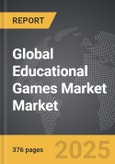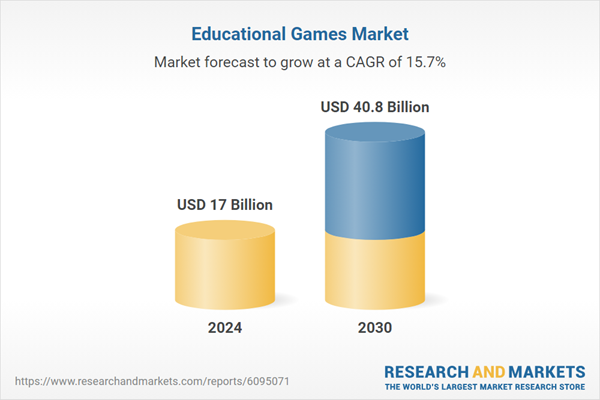Global Educational Games Market - Key Trends & Drivers Summarized
Why Are Educational Games Reshaping Learning Models Across Age Groups and Curricula?
Educational games are emerging as dynamic tools that enhance cognitive engagement, interactivity, and retention across diverse educational settings. Whether deployed in classrooms, homes, or corporate training environments, these games facilitate the learning of complex concepts through immersive storytelling, simulations, and problem-solving challenges. The integration of gamification into learning processes has shown significant benefits in attention span improvement, behavioral engagement, and personalized learning outcomes, particularly in K-12 and early childhood education.The scope of educational games has expanded to cover STEM subjects, language acquisition, history, social skills, and financial literacy. Adaptive learning algorithms and AI-based progression tracking are being used to customize content based on individual learning paces. These games are often deployed on mobile apps, tablets, VR headsets, and web-based platforms, allowing institutions and parents to tailor learning beyond traditional syllabi. The rise of hybrid learning models post-pandemic has only accelerated demand for game-based learning systems that bridge digital and physical educational experiences.
How Are Technology and Content Innovations Enhancing the Appeal and Efficacy of Educational Games?
Technological advancements are transforming the mechanics and delivery of educational games. AI-driven feedback systems, real-time analytics, and voice recognition are enabling differentiated instruction and on-the-go assessments. Augmented Reality (AR) and Virtual Reality (VR) are gaining traction in subjects like geography, biology, and engineering, offering lifelike environments where students can explore without physical constraints. Multiplayer modes and collaborative tasks are enhancing peer learning and communication skills.Content creators are increasingly working with educators, psychologists, and curriculum developers to ensure that games align with academic standards and developmental needs. Gamification elements - such as reward points, achievement badges, and leaderboards - are being intelligently integrated to sustain motivation without encouraging superficial play. Companies are also localizing games to fit linguistic and cultural preferences, expanding their global reach. Subscription-based access, content updates, and cross-platform functionality are further making educational games scalable and future-ready.
Which User Segments and Regions Are Driving Market Adoption of Educational Games?
Primary and secondary schools are the primary users of educational games, especially in the U.S., Canada, UK, China, and Nordic countries, where education budgets support EdTech adoption. Homeschooling parents, special education programs, and early learning centers represent fast-growing demand centers as they look for engaging tools that promote foundational learning. The corporate training sector is also adopting game-based platforms for onboarding, compliance training, and soft skills development.In terms of geography, North America leads in EdTech investments and institutional adoption, supported by strong digital infrastructure. Europe follows closely with structured education reforms incorporating digital learning tools. Asia-Pacific, especially China and India, is experiencing rapid growth in mobile-based educational games driven by student population size, government digital literacy initiatives, and rising private education spending. Latin America and Africa are emerging markets, showing early promise through NGO and government-supported digital literacy programs.
What Factors Are Driving Long-Term Growth and Innovation in the Educational Games Market?
The growth in the educational games market is driven by several factors including rising demand for personalized learning experiences, growing EdTech investments, and the digital transformation of traditional education systems. As education systems increasingly focus on critical thinking, creativity, and 21st-century skills, educational games offer interactive learning pathways that are difficult to achieve through static content. Post-pandemic recovery strategies in education are also prioritizing digital resilience and hybrid learning continuity, further accelerating game adoption.Strategically, publishers and platform developers are forming partnerships with schools, ministries of education, and global organizations to integrate games into formal curricula. There is also a rise in freemium models, teacher dashboards, and data-driven progress analytics that support institutional reporting and intervention. Investment in educational game development studios, especially in mobile-first regions, continues to increase. With a generational shift toward interactive digital-native learning, educational games are no longer supplementary - they are fast becoming essential tools in mainstream education and lifelong learning.
Report Scope
The report analyzes the Educational Games market, presented in terms of market value (US$). The analysis covers the key segments and geographic regions outlined below:- Segments: Type (K-12 Educational Game, University Education Game, Adult Education Game, Elderly Education Game, Other Educational Games); Distribution Channel (Online Distribution Channel, Offline Distribution Channel); Application (Quality-Oriented Education Application, Examination-Oriented Education Application).
- Geographic Regions/Countries: World; United States; Canada; Japan; China; Europe (France; Germany; Italy; United Kingdom; Spain; Russia; and Rest of Europe); Asia-Pacific (Australia; India; South Korea; and Rest of Asia-Pacific); Latin America (Argentina; Brazil; Mexico; and Rest of Latin America); Middle East (Iran; Israel; Saudi Arabia; United Arab Emirates; and Rest of Middle East); and Africa.
Key Insights:
- Market Growth: Understand the significant growth trajectory of the K-12 Educational Game segment, which is expected to reach US$18.9 Billion by 2030 with a CAGR of a 17%. The University Education Game segment is also set to grow at 16.2% CAGR over the analysis period.
- Regional Analysis: Gain insights into the U.S. market, valued at $4.6 Billion in 2024, and China, forecasted to grow at an impressive 20.9% CAGR to reach $9 Billion by 2030. Discover growth trends in other key regions, including Japan, Canada, Germany, and the Asia-Pacific.
Why You Should Buy This Report:
- Detailed Market Analysis: Access a thorough analysis of the Global Educational Games Market, covering all major geographic regions and market segments.
- Competitive Insights: Get an overview of the competitive landscape, including the market presence of major players across different geographies.
- Future Trends and Drivers: Understand the key trends and drivers shaping the future of the Global Educational Games Market.
- Actionable Insights: Benefit from actionable insights that can help you identify new revenue opportunities and make strategic business decisions.
Key Questions Answered:
- How is the Global Educational Games Market expected to evolve by 2030?
- What are the main drivers and restraints affecting the market?
- Which market segments will grow the most over the forecast period?
- How will market shares for different regions and segments change by 2030?
- Who are the leading players in the market, and what are their prospects?
Report Features:
- Comprehensive Market Data: Independent analysis of annual sales and market forecasts in US$ Million from 2024 to 2030.
- In-Depth Regional Analysis: Detailed insights into key markets, including the U.S., China, Japan, Canada, Europe, Asia-Pacific, Latin America, Middle East, and Africa.
- Company Profiles: Coverage of players such as All Things Bugs LLC, Aspire Food Group, Beta Hatch Inc., Bitty Foods, Bugsolutely and more.
- Complimentary Updates: Receive free report updates for one year to keep you informed of the latest market developments.
Some of the 43 companies featured in this Educational Games market report include:
- ABCmouse
- BrainPOP
- Duolingo
- Filament Games
- Kahoot!
- Kuato Studios
- Legends of Learning
- Lingokids
- Marshmallow Games
- Muzzy Lane
- Osmo
- PBS Kids
- PlayMonster
- Prodigy Education
- SplashLearn
- ThinkFun
- Tynker
- Twinkl
- Zcooly
- SimplyFun
This edition integrates the latest global trade and economic shifts into comprehensive market analysis. Key updates include:
- Tariff and Trade Impact: Insights into global tariff negotiations across 180+ countries, with analysis of supply chain turbulence, sourcing disruptions, and geographic realignment. Special focus on 2025 as a pivotal year for trade tensions, including updated perspectives on the Trump-era tariffs.
- Adjusted Forecasts and Analytics: Revised global and regional market forecasts through 2030, incorporating tariff effects, economic uncertainty, and structural changes in globalization. Includes historical analysis from 2015 to 2023.
- Strategic Market Dynamics: Evaluation of revised market prospects, regional outlooks, and key economic indicators such as population and urbanization trends.
- Innovation & Technology Trends: Latest developments in product and process innovation, emerging technologies, and key industry drivers shaping the competitive landscape.
- Competitive Intelligence: Updated global market share estimates for 2025, competitive positioning of major players (Strong/Active/Niche/Trivial), and refined focus on leading global brands and core players.
- Expert Insight & Commentary: Strategic analysis from economists, trade experts, and domain specialists to contextualize market shifts and identify emerging opportunities.
Table of Contents
Companies Mentioned (Partial List)
A selection of companies mentioned in this report includes, but is not limited to:
- ABCmouse
- BrainPOP
- Duolingo
- Filament Games
- Kahoot!
- Kuato Studios
- Legends of Learning
- Lingokids
- Marshmallow Games
- Muzzy Lane
- Osmo
- PBS Kids
- PlayMonster
- Prodigy Education
- SplashLearn
- ThinkFun
- Tynker
- Twinkl
- Zcooly
- SimplyFun
Table Information
| Report Attribute | Details |
|---|---|
| No. of Pages | 376 |
| Published | January 2026 |
| Forecast Period | 2024 - 2030 |
| Estimated Market Value ( USD | $ 17 Billion |
| Forecasted Market Value ( USD | $ 40.8 Billion |
| Compound Annual Growth Rate | 15.7% |
| Regions Covered | Global |









